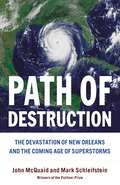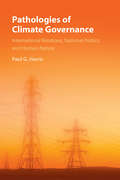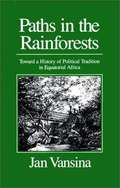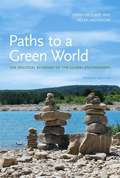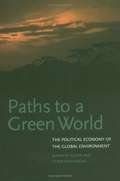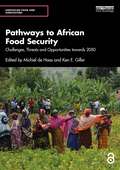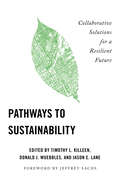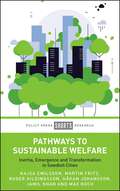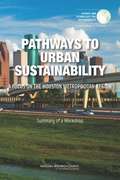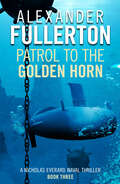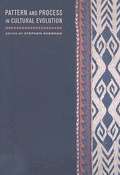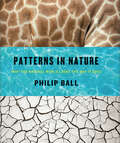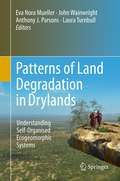- Table View
- List View
Path of Destruction: The Devastation of New Orleans and the Coming Age of Superstorms
by John Mcquaid Mark SchleifsteinAt 5:02 A.M. on August 29, 2005, the power went out in the Superdome. Not long after, wind ripped giant white rubber sheets off the roof and sent huge shards of debris flying toward Uptown. Rivulets of rainwater began finding their way down through the ceiling, dripping and pouring into the stands, the mezzanine, and the football field. Without ventilation, the air began to get gamy with the smell of sweat and garbage. The bathrooms stopped working. Many people slept; others waited, mostly in silence.
Path of the Storm
by Douglas ReemanHong Kong, 1960s: The old submarine-chaser USS Hibiscus, refitting in a Hong Kong dockyard before being handed over to the Nationalist Chinese, is suddenly ordered to the desolate island group of Payenhau. For Captain Mark Gunnar, who is driven by the memory of his torture at the hands of Viet Cong guerillas, the new command is a chance to even the score against a ruthless, unrelenting enemy. But Payenhau is very different from his expectations, and as the weather worsens, a crisis develops that Gunnar must face alone.
Path to Zero: 12 Climate Conversations That Changed the World
by Tucker PerkinsTucker Perkins' Path to Zero shows how we can reverse climate change and create a cleaner environment for future generations by putting aside our biases and working together for change. Climate catastrophe-inspired narratives like &“Electrify Everything!&” have a grip on people&’s minds. The simplicity of the solution to the most complex endeavor ever faced by humans—the journey to a net zero future—is seductive, but it is fundamentally flawed. In Path to Zero: 12 Climate Conversations That Changed the World, author, Tucker Perkins takes readers on a series of future-casting journeys from the Year 2050 back to the present day to show us how a better way—a wide path to net zero carbon emissions—was, and can be, achieved in an accelerated time frame. In this work, Perkins uncovers an array of practical, often obvious, measures the world can take to achieve a better, cleaner future inclusive of energy and power. Unlike other authors and voices of this age, Perkins shows us that change is possible, innovation is happening, and dogmatic devotion to singular solutions is one of the biggest impediments to progress.
Pathlands: 21 Tranquil Walks Among the Villages of Britain
by Peter Owen Jones'When we walk, we walk through two landscapes: an exterior land of trees, seas, cities, mountains and fields but we also follow the paths that lead into our own interior world.'This thoughtful, and beautifully written, book offers 21 circular walks. They span the length and breadth of the British Isles: Suffolk, Northamptonshire, Wiltshire, Wales, Staffordshire, Scotland, Sussex and Cornwall are just a few of the varied landscapes that they cover.As one of the prime 'walks correspondents' of The Sunday Times, Peter Owen Jones already has a loyal following. This book will only increase his audience, and will be both for those who love walking in the countryside and those who enjoy reading, and musing on it, in their armchair at home.
Pathless Forest: The Quest to Save the World’s Largest Flowers
by Dr Chris ThorogoodThe incredible story of one man's obsession to find and protect the world's largest flowers As a child, Chris Thorogood dreamed of seeing Rafflesia - the plant with the world's largest flowers. He crafted life-size replicas in an abandoned cemetery, carefully bringing them to life with paper and paint. Today he is a botanist at the University of Oxford's Botanic Garden and has dedicated his life to studying the biology of such extraordinary plants, working alongside botanists and foresters in Southeast Asia to document these huge, mysterious blooms.Pathless Forest is the story of his journey to study and protect this remarkable plant - a biological enigma, still little understood, which invades vines as a leafless parasite and steals its food from them. We join him on a mind-bending adventure, as he faces a seemingly impenetrable barrier of weird, wonderful and sometimes fearsome flora; finds himself smacking off leeches, hanging off vines, wading through rivers; and following indigenous tribes into remote, untrodden rainforests in search of Rafflesia's ghostly, foul-smelling blooms, more than a metre across.We depend on plants for our very existence, but two in five of the world's species are threatened with extinction - nobody knows how many species of Rafflesia might already have disappeared through deforestation. Pathless Forest is part thrilling adventure story and part an inspirational call to action to safeguard a fast-disappearing wilderness. To view plants in a different way, as vital for our own future as for that of the planet we share. And to see if Rafflesia itself can be saved.
Pathobiology of Marine and Estuarine Organisms (Advances In Fisheries Science Ser.)
by John A. Couch; John W. FourniePathobiology of Marine and Estuarine Organisms is a comprehensive, up-to-date review of aquatic animal pathobiology covering infectious and non-infectious diseases of vertebrates such as marine mammals and fishes, in addition to diseases of invertebrates such as crustacea, mollusks, and lower phyla. The book provides critical information on viral, fungal, bacterial, parasitic, and neoplastic diseases of fish and invertebrates. Written by top-notch experts in the field, Pathobiology of Marine and Estuarine Organisms emphasizes pollution-associated diseases and includes an important review on the effects of pollution on marine mammals. The book will be a welcome addition to the libraries of aquatic and marine biologists, aquatic toxicologists, fisheries biologists, aquaculturalists, fish and invertebrate pathologists, and aquatic animal parasitologists.
Pathologies of Climate Governance: International Relations, National Politics and Human Nature
by Paul G. HarrisEarth's climate is in crisis. Climate governance has failed. This book diagnoses climate governance as if it were a sick patient, uncovering the fundamental factors causing the worsening climate crisis. It distils decades of global climate negotiations to reveal the features of international relations that are impeding climate action, and it identifies political obstacles to climate governance across a variety of countries in the Americas, Asia, and Europe. The psychosocial aspects of climate change are explored to show how human nature, overconsumption, and global capitalism conspire to stymy climate action. Remedies are suggested for how to overcome hurdles to effective climate governance internationally and nationally, with ideas provided for individuals to help them align their own interests with those of the global environment. Covering all of the major recent events in climate politics and governance, this is an accessible book for concerned readers who want to understand the climate crisis.
Paths in the Rainforests: Toward a History of Political Tradition in Equatorial Africa
by Jan VansinaVansina's scope is breathtaking: he reconstructs the history of the forest lands that cover all or part of southern Cameroon, Gabon, Equatorial Guinea, the Congo, Zaire, discussing the original settlement of the forest by the western Bantu.
Paths to a Green World
by Jennifer Clapp Peter DauvergneThis comprehensive and accessible book fills the need for a political economy view of global environmental politics, focusing on the ways international economic processes affect environmental outcomes. It examines the main actors and forces shaping global environmental management, particularly in the developing world. Moving beyond the usual emphasis on international agreements and institutions, it strives to capture not only academic theoretical debates but also views on politics, economics, and the environment within the halls of global conferences, on the streets during antiglobalization protests, and in the boardrooms of international agencies, nongovernmental organizations, and industry associations. The book maps out an original typology of four contrasting worldviews of environmental change--those of market liberals, institutionalists, bioenvironmentalists, and social greens--and uses them as a framework to examine the links between the global political economy and ecological change. This typology provides a common language for students, instructors, and scholars to discuss the issues across the classical social science divisions. The second edition of this popular text has been thoroughly revised and updated to reflect recent events, including the food crisis of 2007-2008, the financial meltdown of 2008, and the Copenhagen Climate Conference of 2009. Topics covered include the environmental implications of globalization; wealth, poverty, and consumption; global trade; transnational corporations; and multilateral and private finance.
Paths to a Green World, second edition: The Political Economy of the Global Environment
by Jennifer Clapp Peter DauvergneA new edition of a book that takes a comprehensive look at the ways economic processes affect global environmental outcomes. This comprehensive and accessible book fills the need for a political economy view of global environmental politics, focusing on the ways international economic processes affect environmental outcomes. It examines the main actors and forces shaping global environmental management, particularly in the developing world. Moving beyond the usual emphasis on international agreements and institutions, it strives to capture not only academic theoretical debates but also views on politics, economics, and the environment within the halls of global conferences, on the streets during antiglobalization protests, and in the boardrooms of international agencies, nongovernmental organizations, and industry associations. The book maps out an original typology of four contrasting worldviews of environmental change—those of market liberals, institutionalists, bioenvironmentalists, and social greens—and uses them as a framework to examine the links between the global political economy and ecological change. This typology provides a common language for students, instructors, and scholars to discuss the issues across the classical social science divisions.The second edition of this popular text has been thoroughly revised and updated to reflect recent events, including the food crisis of 2007-2008, the financial meltdown of 2008, and the Copenhagen Climate Conference of 2009. Topics covered include the environmental implications of globalization; wealth, poverty, and consumption; global trade; transnational corporations; and multilateral and private finance.
Paths to a Green World: The Political Economy of the Global Environment
by Jennifer Clapp Peter DauvergneThis comprehensive and accessible text fills the need for a political economy view of global environmental politics, focusing on the ways key economic processes affect environmental outcomes.
Pathways to African Food Security: Challenges, Threats and Opportunities towards 2050 (Earthscan Food and Agriculture)
by Ken E. Giller Michiel De HaasThis book examines Africa’s current food system and future challenges for food security over the next 25 years.Africa is on the rise and by 2050, the continent will be home to a quarter of the world’s population. The analysis presented in this book clearly shows that the African food system needs to transform at a much faster pace to ensure that the people it serves are food secure. This book begins with four contrasting case studies that focus on country-specific challenges in Egypt, Ethiopia, Senegal and Zimbabwe. This is followed by 15 thematic chapters organised in three sections on challenges, threats and opportunities. Individual chapters address a wide range of topics including climate change, water security, farm sizes, crop yields, conservation trade-offs, food prices, trade, conflict and structural change. The book concludes by discussing key pathways to improve Africa's food system and food security for the decades ahead.This book is essential reading for students, scholars and practitioners who work on global food security, sustainable food systems, food, health and nutrition and African development.
Pathways to Sustainability: Collaborative Solutions for a Resilient Future
by Timothy L. Killeen; Donald J. Wuebbles; Jason E. LaneIn an era defined by unprecedented environmental challenges and rapid societal change, how can we build a sustainable and resilient future? In this collection, the editors bring together groundbreaking insights and inspiring stories from around the globe, illuminating how innovative partnerships across sectors and borders are driving meaningful progress toward sustainability. Contributors from science, business, non-governmental organizations, and university leadership engage across their areas of expertise to discuss how to apply cutting-edge research toward understanding, mitigating, and adapting to today’s alarming environmental stresses. Throughout, the essayists showcase breakthroughs in sustainability science while providing a blueprint for creating collaborations, expanding networks, and connecting with new markets. Essential reading for sustainability leaders, educators, policymakers, and change-makers everywhere, this volume offers a visionary yet practical roadmap for harnessing the power of collaboration to advance practical solutions necessary to ensure a thriving planet for future generations. Expert and interdisciplinary, Pathways to Sustainability focuses on human capacity building and innovation to explore holistic solutions to climate change, unsustainable resource consumption, and other inevitable challenges of our time. Contributors: Nicole Arbour, Rebecca T. Barnes, Kyle Blount, Kayla Boparai, Caleb S. Brooks, Benjamin B. Campion, Christopher Castle, William L. Chadderton, Kenneth T. Christensen, Emily M. Clegg, Asher Cohen, Jonathan Coppess, Nathan L. Cummins, John D. Den Uyl, Miranda N. Domico, Francina Dominguez, Patrick J. Doran, Kelvin K. Droegemeier, Pengyue Du, Luis Gomez Echeverri, Brian Fath, John Ferry, Trent W. Ford, Regina Mae Francia, Georgie B. Geraghty, Janet Gooch, Timothy P. Grunloh, Kaiyu Guan, Luiz Gutierrez, Sam S. Haapaniemi, Julian Heiss, Barb Helland, Catherine Hurley, Atul K. Jain, Paul Kearns, Timothy L. Killeen, Rao Kotamarthi, Jason E. Lane, Wendy Larner, John T. Legge, L. Ruby Leung, Peiyuan Li, Leila Loupis, Josephine M. Malonza, Mark Manns, Lia Merminga, Maria J. Molina, David Muchangi Mugo, Meridith F. Muth, Selvaprabu Nadarajah, Cristina Negri, Pratik Patil, Andreas F. Prein, Ziqi Qin, Fany Ramos Quispe, Jonathan Radcliffe, Omer Rana, Dan Reed, Alyssa Rodway, Christine Rovelli, Elena Rovenskaya, Gabriella Pinheiro Servi, Gavin Shaddick, John Shalf, Ashish Sharma, Bjorn Stevens, Tih-Fen Ting, Dennis Todey, John Towns, Andrew J. Tucker, Albert van Jaarsveld, Carolina Veiga, Abhinav Wadhwa, Peter W. Wangai, Melissa Widhalm, Aaron B. Wilson, Molly Woloszyn, Sicheng Wu, Donald J. Wuebbles, and Joel Zavala
Pathways to Sustainable Welfare: Inertia, Emergence and Transformation in Swedish Cities
by Håkan Johansson Max Koch Martin Fritz Kajsa Emilsson Roger Hildingsson Jamil KhanAvailable open access digitally under CC-BY-NC-ND licence. Pathways to Sustainable Welfare critically examines how cities can address the dual challenges of climate change and sustainability while ensuring the welfare of their populations. Focused on three Swedish cities, it explores the integration of environmental and welfare concerns in local policies, urban movements and public opinions. Based on theories of inertia, emergence and transformation, it identifies factors driving or obstructing sustainable welfare advancements. This book is a crucial resource for scholars interested in sustainable transformation, urban governance and social policy. It offers frameworks and empirical evidence relevant to academics, policy makers and practitioners seeking to understand and engage in urban sustainable welfare development.
Pathways to Urban Sustainability
by Dominic A. BroseThe workshop was convened to explore the region's approach to urban sustainability, with an emphasis on building the evidence base upon which new policies and programs might be developed. Participants examined how the interaction of various systems (natural and human systems; energy, water, and transportation systems) affected the region's social, economic, and environmental conditions. The objectives of the workshop were as follows: - Discuss ways that regional actors are approaching sustainability- specifically, how they are attempting to merge environmental, social, and economic objectives. - Share information about ongoing activities and strategic planning efforts, including lessons learned. - Examine the role that science, technology, and research can play in supporting efforts to make the region more sustainable. - Explore how federal agency efforts, particularly interagency partnerships, can complement or leverage the efforts of other key stakeholders. Pathways to Urban Sustainability: A Focus on the Houston Metropolitan Region: Summary of a Workshop was designed to explore the complex challenges facing sustainability efforts in the Houston metropolitan region and innovative approaches to addressing them, as well as performance measures to gauge success and opportunities to link knowledge with action. In developing the agenda, the planning committee chose topics that were timely and cut across the concerns of individual institutions, reflecting the interests of a variety of stakeholders. Panelists were encouraged to share their perspectives on a given topic; however, each panel was designed to provoke discussion that took advantage of the broad experience of the participants.
Pathways to Urban Sustainability: Summary of a Workshop
by Dominic A. BroseThe workshop was convened to explore the region's approach to urban sustainability, with an emphasis on building the evidence base upon which new policies and programs might be developed. Participants examined how the interaction of various systems (natural and human systems; energy, water, and transportation systems) affected the region's social, economic, and environmental conditions. The objectives of the workshop were as follows: - Discuss ways that regional actors are approaching sustainability- specifically, how they are attempting to merge environmental, social, and economic objectives. - Share information about ongoing activities and strategic planning efforts, including lessons learned. - Examine the role that science, technology, and research can play in supporting efforts to make the region more sustainable. - Explore how federal agency efforts, particularly interagency partnerships, can complement or leverage the efforts of other key stakeholders. Pathways to Urban Sustainability: A Focus on the Houston Metropolitan Region: Summary of a Workshop was designed to explore the complex challenges facing sustainability efforts in the Houston metropolitan region and innovative approaches to addressing them, as well as performance measures to gauge success and opportunities to link knowledge with action. In developing the agenda, the planning committee chose topics that were timely and cut across the concerns of individual institutions, reflecting the interests of a variety of stakeholders. Panelists were encouraged to share their perspectives on a given topic; however, each panel was designed to provoke discussion that took advantage of the broad experience of the participants.
Patrol to the Golden Horn (Nicholas Everard Naval Thrillers)
by Alexander FullertonNicholas Everard is ready to run the gauntlet in his most dangerous mission yet…The menacing bulk of the German battlecruiser Goeben lurks in the Golden Horn of Constantinople. It is vital that she is destroyed, and the plan is to send an E-class submarine in through the Dardanelles to sink her unawares.But it has been two years since an Allied submarine passed through the narrow straits successfully, littered as they are with minefields, nets and depth charges dropped by the gunboats endlessly patrolling above.To send a crew in now would be a death sentence, but sparing the Goeben is unthinkable. Enter Nick Everard.An unputdownable story of the final days of WWI, perfect for fans of Douglas Reeman and Patrick O’Brian.Praise for Alexander Fullerton‘The most meticulously researched war novels that I have ever read' Len Deighton
Patrol to the Golden Horn (Nicholas Everard Naval Thrillers)
by Alexander FullertonNicholas Everard is ready to run the gauntlet in his most dangerous mission yet…The menacing bulk of the German battlecruiser Goeben lurks in the Golden Horn of Constantinople. It is vital that she is destroyed, and the plan is to send an E-class submarine in through the Dardanelles to sink her unawares.But it has been two years since an Allied submarine passed through the narrow straits successfully, littered as they are with minefields, nets and depth charges dropped by the gunboats endlessly patrolling above.To send a crew in now would be a death sentence, but sparing the Goeben is unthinkable. Enter Nick Everard.An unputdownable story of the final days of WWI, perfect for fans of Douglas Reeman and Patrick O’Brian.Praise for Alexander Fullerton‘The most meticulously researched war novels that I have ever read' Len Deighton
Patrones de la naturaleza (¡Arriba la Lectura!, Level Q #77)
by Pamela RushbyNIMAC-sourced textbook
Pattern and Process in Cultural Evolution
by Stephen ShennanThis volume offers an integrative approach to the application of evolutionary theory in studies of cultural transmission and social evolution and reveals the enormous range of ways in which Darwinian ideas can lead to productive empirical research, the touchstone of any worthwhile theoretical perspective. While many recent works on cultural evolution adopt a specific theoretical framework, such as dual inheritance theory or human behavioral ecology,Pattern and Process in Cultural Evolution emphasizes empirical analysis and includes authors who employ a range of backgrounds and methods to address aspects of culture from an evolutionary perspective. Editor Stephen Shennan has assembled archaeologists, evolutionary theorists, and ethnographers, whose essays cover a broad range of time periods, localities, cultural groups, and artifacts.
Patterns from the Golden Age of Rustic Design: Park and Recreation Structures from the 1930s
by Albert H. GoodContaining over 1200 photographs and detailed line drawings from which one can design and build directly, Patterns from the Golden Age of Rustic Design is a valuable reference for preservationists, historians, designers, and homeowners. Albert Good provided plans for the construction of cabins, lodges, hotels, fireplaces, boat houses, furniture, fixtures, and more. Initially developed as a teaching tool for designers in the 1930s, this book is for anyone who has a desire to duplicate the classic, rustic structures commonly found in state and national parks. The designs extend to the use of stone in New England and the proliferation of the pueblo and mission styles in the southwest, as well as structures made of logs and mortar. In this informative treasure of a design book, you will find that the author reached his principal goal to present structures that "appear to belong and be a part of their settings."
Patterns in Nature: Why the Natural World Looks the Way It Does
by Philip BallThe acclaimed science writer &“curates a visually striking, riotously colorful photographic display…of physical patterns in the natural world&” (Publishers Weekly, starred review). Though at first glance the natural world may appear overwhelming in its diversity and complexity, there are regularities running through it, from the hexagons of a honeycomb to the spirals of a seashell and the branching veins of a leaf. Revealing the order at the foundation of the seemingly chaotic natural world, Patterns in Nature explores not only the math and science but also the beauty and artistry behind nature&’s awe-inspiring designs. Unlike the patterns we create, natural patterns are formed spontaneously from the forces that act in the physical world. Very often the same types of pattern and form—such as spirals, stripes, branches, and fractals—recur in places that seem to have nothing in common, as when the markings of a zebra mimic the ripples in windblown sand. But many of these patterns can be described using the same mathematical and physical principles, giving a surprising unity to the kaleidoscope of the natural world. Richly illustrated with 250 color photographs and anchored by accessible and insightful chapters by esteemed science writer Philip Ball, Patterns in Nature reveals the organization at work in vast and ancient forests, powerful rivers, massing clouds, and coastlines carved out by the sea. By exploring similarities such as the branches of a tree and those of a river network, this spectacular visual tour conveys the wonder, beauty, and richness of natural pattern formation.
Patterns of Land Degradation in Drylands: Understanding Self-Organised Ecogeomorphic Systems
by John Wainwright Anthony J. Parsons Eva Nora Mueller Laura TurnbullThis book explores the theory of ecogeomorphic pattern-process linkages, using case studies from Europe, Africa, Australia and North America. Sets forth a research agenda for the emerging field of ecogeomorphology in drylands land-degradation studies.
Paul J. Crutzen and the Anthropocene: A New Epoch in Earth’s History (The Anthropocene: Politik—Economics—Society—Science #1)
by Hans Günter Brauch Paul J. Crutzen Susanne Benner Gregor Lax Ulrich Pöschl Jos LelieveldThis book outlines the development and perspectives of the Anthropocene concept by Paul J. Crutzen and his colleagues from its inception to its implications for the sciences, humanities, society and politics.The main text consists primarily of articles from peer-reviewed scientific journals and other scholarly sources. It comprises selected articles on the Anthropocene published by Paul J. Crutzen and a selection of related articles, mostly but not exclusively by colleagues with whom he collaborated closely.• In the year 2000 Nobel Laureate Paul J. Crutzen proposed the Anthropocene concept as a new epoch in Earth’s history • Comprehensive collection of articles on the Anthropocene by Paul J. Crutzen and his colleagues• Unique primary research literature and Crutzen’s comprehensive bibliography• Paul Crutzen’s scientific investigations into human influences on atmospheric chemistry and physics, the climate and the Earth system, leading to the conception of the Anthropocene• Reflections on the Anthropocene and its implications• Bibliometric review of the spread of the use of the Anthropocene concept in the Natural and Social Sciences, Humanities and Law
